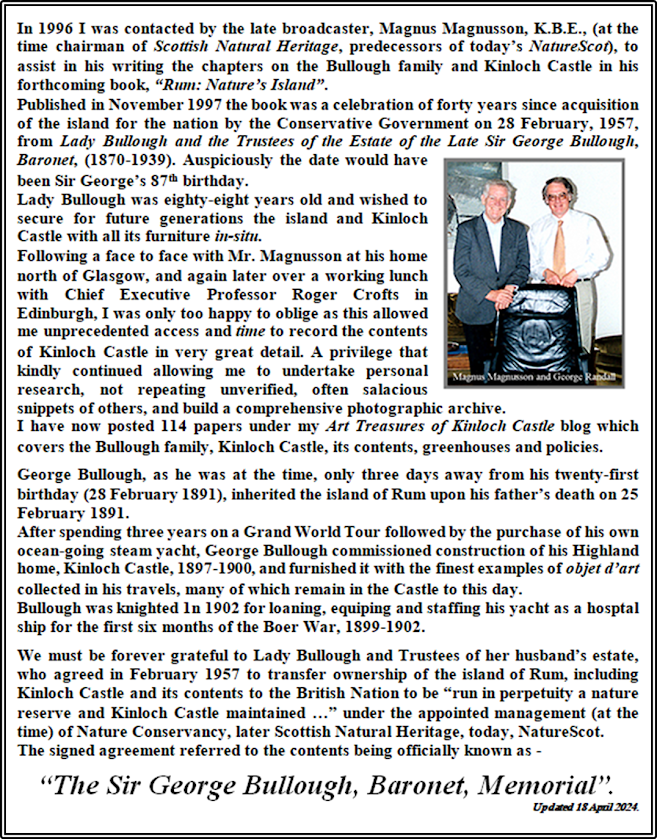JAPANESE ONI WARRIORS
AND CHINESE ARTEFACTS
First hand research and photographs by George W. Randall
First hand research and photographs by George W. Randall
co-founder in 1996 and former
Vice Chairman Kinloch Castle Friends' Association
A pair of red lacquer figures of Oni in full battledress carrying a
barrel suspended from a large kanabō (a knobbed wooden club)
used as a weapon in Buddhist feudal Japan to cripple the opponent rather than kill. Each figure holds a small kanabō in his left hand.
The visible end of the barrel has two partly open hinged doors
revealing four drawers.
To each side of the barrel is a double tassel suspended from a hook. Small pegs on the feet of the figures secure them to their ornately carved cinnabar and lacquer base which bears the gold coloured
Trade Mark of Kuhn & Komor, Yokohama and Hong Kong.

Kuhn and Komor was a Japanese curio business established by Isidor Komor and his cousin Arthur Kuhn in 1897, their China premises being opened the following year in the Palace Hotel, Shanghai, followed by stores in Hong Kong, Kobe and Singapore.
The image to the right was published in “Scotland’s Magazine” in December 1959, thirty-four months after purchase of the 26,400 acre island and Kinloch Castle by the Conservative Government of the day.
Despite being recognised as a fully furnished time capsule of the
late Victorian/Edwardian Era subsequent use of the building as
a hotel in the late 1980’s to 1994, allowed guests complete freedom
to roam resulting in wear and tear plus inevitable damage to
a number of contents, including the Oni.
Kuhn and Komor was a Japanese curio business established
by Isidor Komor and his cousin Arthur Kuhn in 1897, their China premises being opened the following year in the Palace Hotel, Shanghai, followed by stores in Hong Kong, Kobe and Singapore.
The image top right was published in “Scotland’s Magazine”
The image top right was published in “Scotland’s Magazine”
in December 1959, thirty-four months after purchase of the
26,400 acre island and Kinloch Castle by the
Conservative Government of the day. Despite being recognised
as a fully furnished time capsule of the late Victorian/Edwardian Era subsequent use of the building as a hotel in the late 1980’s to 1994, allowed guests complete freedom to roam resulting in wear and tear plus inevitable damage to a number of contents, including the Oni.
*
************************************
CHINESE AND JAPANESE TREASURES AT RISK
Research and Text by George W. Randall
 |
in diameter, and is painted with shaped panels of Shou Lao
(the stellar deity of longevity), deer, mon (family insignia),
butterflies and flowers.
Made in Arita, close to the town of Nagasaki on the island of Kyushu, “Imari” porcelain is named after the south Japanese port
Made in Arita, close to the town of Nagasaki on the island of Kyushu, “Imari” porcelain is named after the south Japanese port
from which it was exported to America and Europe.
It has a characteristic decoration, aka-e (first produced circa. 1640)
It has a characteristic decoration, aka-e (first produced circa. 1640)
in blue with added red, gilt and other bright enamels.
George W. Randall Archive Copyright ©
***********************************************
JAPANESE
THREE-FOLD SILK EMBROIDERED SCREEN
Also in the Library is a Japanese three-fold screen each large embroidered silk panel within a carved wood mount of Prunus speciosa, the Oshima Cherry, depicting numerous species of birds, above each a much smaller panel, encased in a carved mount of dragons, portraying birds and flowers.
Each large leaf measures 68 inches (173 cms.) by 25½ inches (65 cms.).
The central panel was described as “detached” in the 1979 Inventory and was photographically recorded as such in 2012 - thirty-three years later - suffering brown staining along the bottom edge due to being stored directly on a wooden parquet floor close to double French doors.
The central panel was described as “detached” in the 1979 Inventory and was photographically recorded as such in 2012 - thirty-three years later - suffering brown staining along the bottom edge due to being stored directly on a wooden parquet floor close to double French doors.
The middle panel is "detached". Reverse of "detached" panel.
The staining clearly visible along the lower edges.
Photography fails to capture the glistening sheen
in these magnificent silk embroidered panels!
George W. Randall Archive Copyright ©
*************************************************
UPDATED 27 JUNE 2024
UPDATED 27 JUNE 2024















